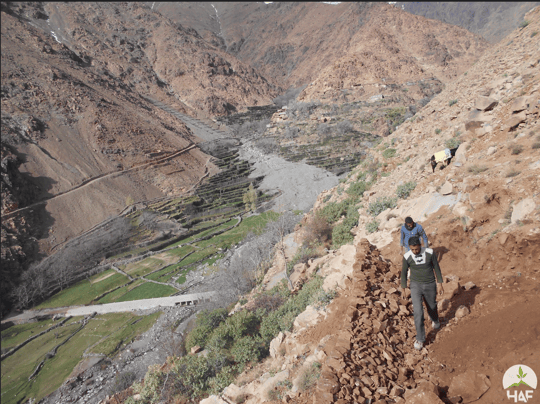By Errachid Montassir
Project Manager, Sami’s Project
Driving 70 kilometers on a unpaved road from the Aouloz commune in the province of Taroudant, you will find Lake Ifni nestled amid the towering peaks of the Tigolal mountains, near Mount Toubkal. This blue lake, according to local people, is a place that many young and hopeful brides come to visit.Lake Ifni’s life began 245 million years ago. There are two sources of the lake’s origin: the first is due to volcanic activity forming the crater, and the second is the accumulated snowfall and its melting – over millennia – filling the large indentation with water. Lake Ifni is at an altitude of 2,395 meters. The length of the lake is 900 meters and its width extends to a distance of 400 meters. Its effluent level – or the amount of water it discharges – is at approximately 300 meters per second.
The Regional Management of Waters and Forests and its agency, the Toubkal National Park Management, recently organized a workshop with the immediate beneficiaries of Lake Ifni – the people of the Tifnoute Valley – to create together a sustainable development plan. Mr. Mohamed Issoual, the Regional Director of Waters and Forests, focused with the workshop participants on the need to work collaboratively to maintain the lake as: a water source upon which thousands of families depend for drinking and agriculture; the beginning waters that eventually contributes to the Souss Massa basin about 200 kilometers away; and as a majestic destination that draws visitors from around the world.
In partnership with the United Nations Development Program and the local Toubkal Association, the High Atlas Foundation is assisting the development and implementation of a new plan, dedicated to enhancing both livelihoods and preservation. As part of the workshop, we support the efforts of Waters and Forests and the integration of the people and associations into the process of designing actions for livelihoods and sustainable management systems for the lake.
Since 2003, we have been working closely with the Tifnoute people, growing nurseries and hundreds of thousands of trees (in memory of RPCV Kate Jeans-Gail), securing organic certification of walnuts and almonds, building drinking water systems with 12 villages, promoting opportunities with women’s coops, and engaging schoolchildren in environmental activities. Using the participatory approach, we created a municipal development plan, engaging all the Valley’s 44 villages.
The trust we have built with the Tifnoute people is derived from a long extension of advancing with them sustainable projects. This lake project came several years ago from the community mapping activity we conducted with local people neighboring the lake.
The first day of the workshop began with a detailed presentation from the director of the Toubkal National Park, Ms. Soraya Mokhtari. She spoke about the context and framework of this project, leading to the 2020 plan for Protected Areas in Morocco. Professor Lamiae Kacem of Marrakech presented substantial knowledge about Lake Ifni and its watershed, including its geographic scope and difficulties facing the Lake.
Mr. Larbi Didouqen of HAF discussed with the workshop participants the opportunities associated with the new project, such as actions for the rehabilitation of ecosystems and preservation of threatened vegetation and wildlife species. Participants then discussed the advantages of the lake:
– As a vital source of water
– The environmental and agricultural benefits
– The cultural heritage
– Its governance and new partnerships to support this
– Its touristic feature
These are all essential reason to develop an integrated, participatory, and sustainable management plan for the Lake. However, we must address as part of this initiative the difficult obstacles: the absence of guides, waste pollution, deforestation, and the few local products available to visitors.
The discussions surrounding the development plan ended with consensus around several points, which will be part of the project solutions to which we are committed:
– Alleviating erosion
– Grow vegetation
– Initiate waste management
– Provide clean water and other infrastructure
– Establish a guidance center in the area
The following day we visited Lake Ifni with members of Waters and Forests, the park management, and local associations. There we together fortified our agreement and collaboration to work together for this initiative and will bring our best support for the highest lake in Morocco and the people who depend upon it
